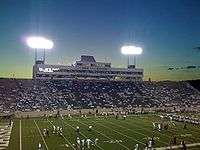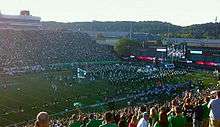Joan C. Edwards Stadium
| "The Joan" | |
|
| |
| Former names | Marshall University Stadium (1991–2003) |
|---|---|
| Location |
2001 3rd Avenue Huntington, West Virginia 25755 USA |
| Coordinates | 38°25′30″N 82°25′15″W / 38.42500°N 82.42083°WCoordinates: 38°25′30″N 82°25′15″W / 38.42500°N 82.42083°W |
| Owner | Marshall University |
| Operator | Marshall University |
| Executive suites | 20 |
| Capacity |
28,000 (1991-1993) 30,000 (1994–1999) 38,019 (2000–2012) 38,227 (2013–present) |
| Record attendance | 41,382 |
| Surface |
Omniturf 1991 to 1997 AstroTurf 1998 to 2004 FieldTurf 2005 to 2013 AstroTurf 2014 to present |
| Construction | |
| Broke ground | July 18, 1990 |
| Opened | September 7, 1991 |
| Construction cost |
$30 million ($52.1 million in 2016 dollars[1]) |
| Architect | Rosser FABRAP |
| General contractor | Frank Irey Company/River Cities[2] |
| Tenants | |
|
Marshall Thundering Herd (NCAA) (1991–present) NCAA Division I Football Championship (1992–1996) | |
Joan C. Edwards Stadium is a football stadium located on the campus of Marshall University in Huntington, West Virginia, United States. It can hold 38,227[3] spectators and includes twenty deluxe, indoor suites, 300 wheelchair-accessible seating, a state-of-the-art press-box, 14 concession areas, and 16 separate restrooms.[4] It also features 90,000 sq ft (8,000 m2). of artificial turf and 1,837 tons of structural steel. It also houses the Shewey Athletic Center, a fieldhouse and a training facility. The new stadium replaced Fairfield Stadium, a condemned off-campus facility built in 1927 in the Fairfield Park neighborhood.
Marshall has a 140-25 overall record at Joan C. Edwards stadium for a winning percentage of .848, which is the second highest home winning percentage of any FBS team at its current home venue. Baylor University tops the list at 4-0 (1.000) in their first year at McLane Stadium.[5][6]
History
The Joan C. Edwards Stadium was first proposed in 1986 to replace Fairfield Stadium.[4] On January 16, then-Governor Arch A. Moore Jr. met with Huntington and University leaders, stating that "money is available" if the plans for the stadium were put together. On June 15, the Board of Regents gives the green light to the new stadium project; on September 9, the university begins purchasing property east of the central campus for the proposed stadium.
On January 15, 1987, Governor Moore asks the Board of Regents to approve funding for the sale of bonds that would help finance the new stadium.[4] On June 8 of the following year, the state Legislature passes a state budget which has the inclusion of a new 30,000-seat stadium if the Board of Regents can secure funding. A little over one month later on June 9, the Board of Regents passes a resolution that endorsed the construction of a new football stadium.
On October 4, 1988, a rendering of the new stadium was unveiled.[4] The designers of the new facility were Stafford/Rosser Fabrap, a joint venture between Stafford Consultants of Princeton, West Virginia and Rosser Fabrap International of Atlanta, Georgia. Soon after, the Board of Regents were given 1,800 sq ft (170 m2). of property by the Greater Huntington Area Chamber of Commerce. On November 1, the Board of Regents purchased additional property and hired investment bankers who helped decide the optimal financing method for the project.
On January 11, 1989, the Board of Regents approved a $70 million bond sale, $30 million of which was for the new Marshall stadium.[4] Demolition of the existing structures for the new stadium began on December 9. A contract for the new stadium was awarded on June 13, 1990 to RC-Irey, a joint venture between River City Construction Company of Huntington and the Frank Irey, Jr. Company of Monongahela, Pennsylvania. Groundbreaking ceremonies took place one month later on July 18. By October 6, 1990, steel beams were being erected for the new stadium. Marshall's "Thundering Herd" played their last game at Fairfield Stadium against Eastern Kentucky University on November 10, losing 12–15.[4]
On January 19, 1991, the designers admitted there was only room for 28,000 seats, not the original 30,000 due to an error in calculating the size of the chairback seats.[4] The remaining 2,000 were to be added to the south end zone after the 1991 season. It would be the sixth largest stadium in NCAA Division I-AA football. By May 3 of that year, it was announced that the stadium was ⅔ complete and on August 9, the "Thundering Herd's" freshmen and transfers held their first practice in the new stadium.
On September 7, 1991, the new Marshall Stadium was unveiled before a crowd of 33,116.[4] The opening game was against New Hampshire, which Marshall won, 24–23. One year later in July, Marshall football staff and administrators relocated into a new facilities structure at the north end of the stadium adjacent to 3rd Avenue.
In 2000, a bronze memorial to the 1970 plane crash that killed most of the football team was placed on the front of the stadium to the left of the main tower, and the road the stadium is on was renamed "Marshall Memorial Boulevard."
The expansion of the additional 2,000 seats was completed in July 1994. Six years later, in August 2000, another seating expansion brought the total number of seats to 38,019. The new expansion was completed before the 2000 season opener against SE Missouri St. In 2013, Marshall added four new skyboxes which raised the capacity to 38,227[3]
In 2005, the stadium underwent a change in the playing surface as the AstroTurf surface, in place since 1998, was removed, and a new FieldTurf surface was installed. In 2014, AstroTurf was reinstalled.[7]
The record attendance was set on September 10, 2010 at 41,382 in a 24–21 overtime loss to West Virginia University.[8]
Naming
On September 4, 1993, the playing surface was named in honor of James F. Edwards, a donor to Marshall University.[4] On November 28, 2003, the Marshall Stadium was renamed to the Joan C. Edwards Stadium in honor of her contributions and that of James who had donated $65 million to the university. The Shewey Athletic Center on the north side of the stadium on 3rd Avenue was named for Fred and Christine Shewey who were also major donors. The Shewey Athletic Center houses the stadium's locker room facilities as well as offices for both the football team and the athletic department.
The stadium is one of only two in NCAA Division I named exclusively for a woman. The other is Williams-Brice Stadium at South Carolina. (Several other stadiums are named after husband-and-wife pairs.)
Tenants
In addition to hosting Marshall football, the NCAA Division I-AA national championship game was held at then-Marshall University Stadium several times in the 1990s, including in 1992 and 1996—the years when the Thundering Herd won the national championship. The stadium also hosted the MAC championship game in 1997, 1998, 1999, 2000 and 2002 as well as the 2014 Conference USA championship game.
In 2010, Kentucky Christian University played three of its home football games at the stadium.[9]
Gallery
-

Front entrance to stadium
-

Memorial located on the front of the stadium
-

Home Side 2008
-

Visitor Side Exterior 2008
-
The Joan at dusk 2009
-

Marshall vs Cincinnati 2008 (pregame)
-
Marshall vs Houston 2008
-

Pregame as seen from the student section in 2012. The Shewey Athletic Facility is seen at the far end of the field.
See also
References
- ↑ Consumer Price Index (estimate) 1800–. Federal Reserve Bank of Minneapolis. Retrieved November 10, 2015.
- ↑ "Joan C. Edwards Stadium". Ballparks.com. Retrieved November 25, 2013.
- 1 2 "Herd Notebook: Upstairs, Jerseys, Turf". Marshall Athletics. Retrieved August 25, 2013.
- 1 2 3 4 5 6 7 8 9 "Timeline of Joan C. Edwards Stadium". The Herald-Dispatch (Huntington, WV). December 19, 2006. Retrieved December 19, 2006.
- ↑ Curtis, Jake. "Marshall thundering toward 13-0 record". SFGate. SFGate. Retrieved 19 Nov 2014.
- ↑ "Boise State Hosts San Diego State Saturday". Bronco Sports. Boise State University. Retrieved 19 Nov 2014.
- ↑ "‘THE JOAN’ GETS NEW SURFACE". AstroTurf.com. Retrieved May 6, 2014.
- ↑ "No. 23 WVU rallies, escapes Marshall upset in OT". ESPN. Retrieved September 10, 2010.
- ↑ "Kentucky Christian to play 3 games at Marshall". Charleston Daily Mail. August 19, 2010. Retrieved September 12, 2010.
External links
| Wikimedia Commons has media related to Joan C. Edwards Stadium. |
| Preceded by Paulson Stadium |
Home of the NCAA Division I-AA National Championship 1992–1996 |
Succeeded by Finley Stadium |
| ||||||||||||||||||||||
| ||||||||||||||||||||||||||
| ||||||||||
| ||||||||||
| ||||||||||||||||||||||||||||||||||||||